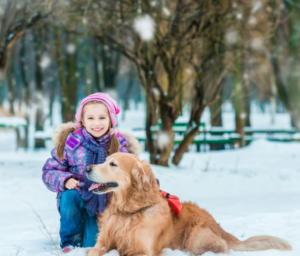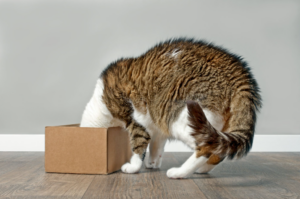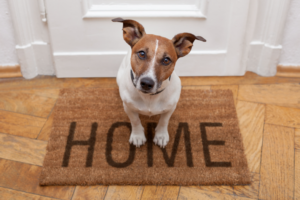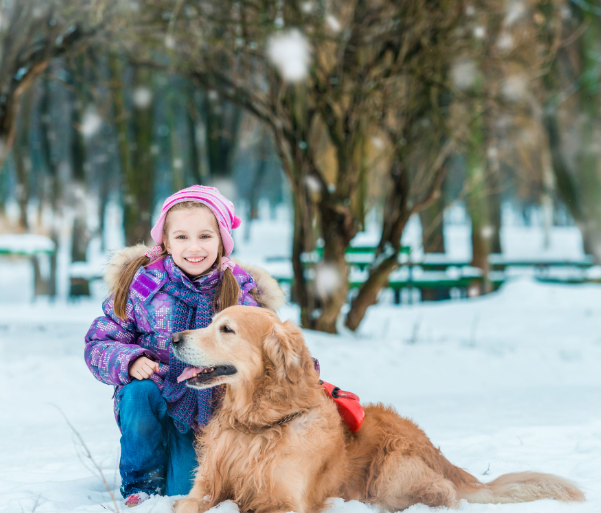Winter Tips for Keeping Your Pet Occupied and Content
Writer / Tara Marie Dorsett
Photography Provided
“Are you serious? You really want out?”
I glanced from my dog to the window, where I could see small tornadoes of snow swirling through the trees. She wagged her tail expectantly.
I sighed. “OK, give me a minute.” 
On went the snow pants, boots, hat and gloves.
“You sure you want out?”
The husky swiped her front paw across the doorknob, and I slid into my jacket.
The frozen air of winter met us as we crunched down the snow-covered steps, crossed the white lawn of our apartment building, slid around the gate that separated the apartments from the park, and pushed through the three-foot mounds of soft snow that covered the ground. I mindlessly followed my excited dog as she explored her winter world.
Not all of us are cold-weather fans. Some people and their four-footed companions enjoy the icy air and glittery snow. Others prefer warm temperatures and green grass. I was caught in a relationship in which my dog loved the cold and I could tolerate it in short increments.
For those of you who fall into the second category, I have a few indoor ideas to keep humans and animals sane until spring arrives.
 Boxes. Yep, those plain brown cardboard boxes that start piling up around the house this time of year will keep your sanity intact for a few more hours. Instead of throwing the boxes away or folding them into the recycling bin, put them in a spare closet or unused space. Keep every size and shape. Once you have a nice stash, take some, scatter a few toys or treats in them, stack the boxes a few rows high. Show your pet how to push the boxes over and find the treats or toys. You can also cut the boxes into chunks, toss the cardboard pieces in a pile, and add a few treats or toys under and around the cardboard for your pet to find.
Boxes. Yep, those plain brown cardboard boxes that start piling up around the house this time of year will keep your sanity intact for a few more hours. Instead of throwing the boxes away or folding them into the recycling bin, put them in a spare closet or unused space. Keep every size and shape. Once you have a nice stash, take some, scatter a few toys or treats in them, stack the boxes a few rows high. Show your pet how to push the boxes over and find the treats or toys. You can also cut the boxes into chunks, toss the cardboard pieces in a pile, and add a few treats or toys under and around the cardboard for your pet to find.
Plastic bottles. Even during winter it is important to stay hydrated, and all those empty bottles from trying to drink the recommended amount of fluid per day add up. Before you toss them into a bin, try this. Rinse the bottles and let them dry on the inside. Any plastic bottle size will work. Keep the size of your pet in mind when choosing bottles. A two-liter bottle might not be the best option for a Chihuahua, but they do have big attitudes and might prefer a bottle twice their size. Likewise, a four-ounce bottle might be too small for a Great Dane to play with safely. Decide what size your pet is most comfortable handling before tossing a few treats or pieces of dry food – kibble, crackers, cheerios, – into the bottles. Leave the caps off. You probably already have your pet’s attention, but in case you don’t, call him and show him the bottle. Shake the bottle, set it on the floor, gently roll it or do all three. Once your pet realizes something good is inside the bottle, she will do everything she can to get those tidbits to tumble out.
Laser lights. While not everyone is a fan of letting their pets chase an uncatchable red or green shape around the room, I love playing this game with my critters. My ferrets will chase this small light for hours. It’s the perfect way to help them burn energy. You can even toss your pet a treat occasionally to reward his efforts.
Prepping for spring. Teach your pet to walk beside you off-leash. Decide what word you are going to use for this command. Common phrases are “heel,” “walk” and “let’s go.” It doesn’t matter what word combination you use, but be consistent. Grab a special treat or toy – something your pet really likes or gets occasionally. You will want to be in a room that has plenty of space for walking in straight lines, making sudden turns, running and stopping.
Lead your pet to the training area. Show your pet the item in your hand. Always keep the treat or toy in the hand closest to your pet. If your dog is standing on your right side, the toy/treat should be in your right hand. Say your preferred word and take a few steps forward. As your dog/cat/hamster walks with you, give small pieces of treat or let him/her chew on the toy. Give lots of calm verbal praise. Once your pet understands what to do, change your pace or the direction you are walking. Throw in a few unexpected stops. Don’t rush things. The better your pet is at staying beside you off-leash, the easier it will be for him to master walking with you on a leash when you need to add one to his training. Want some more ideas? Email me at taramarie611@gmail.com.





